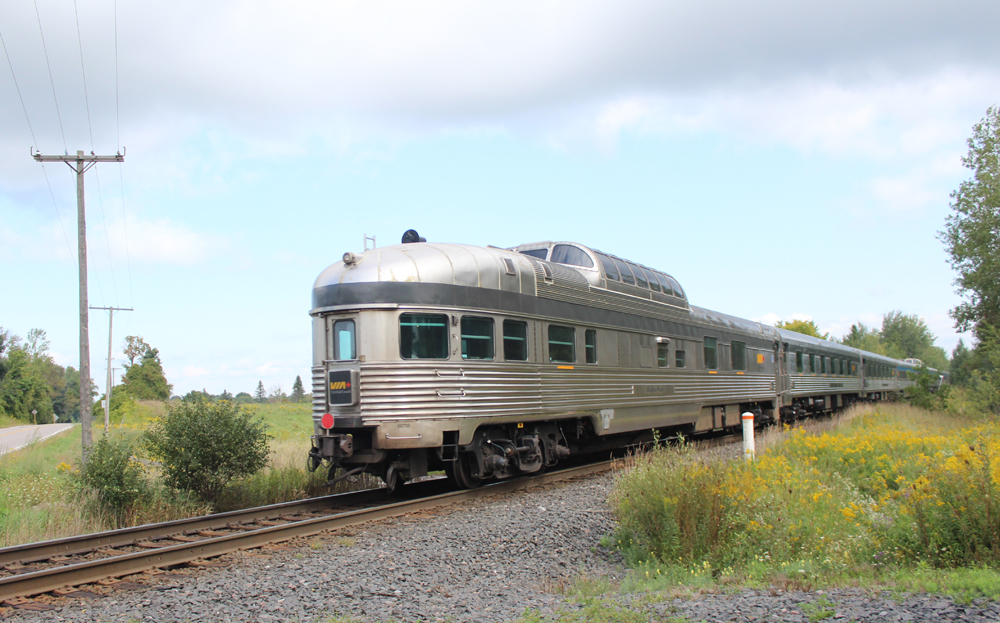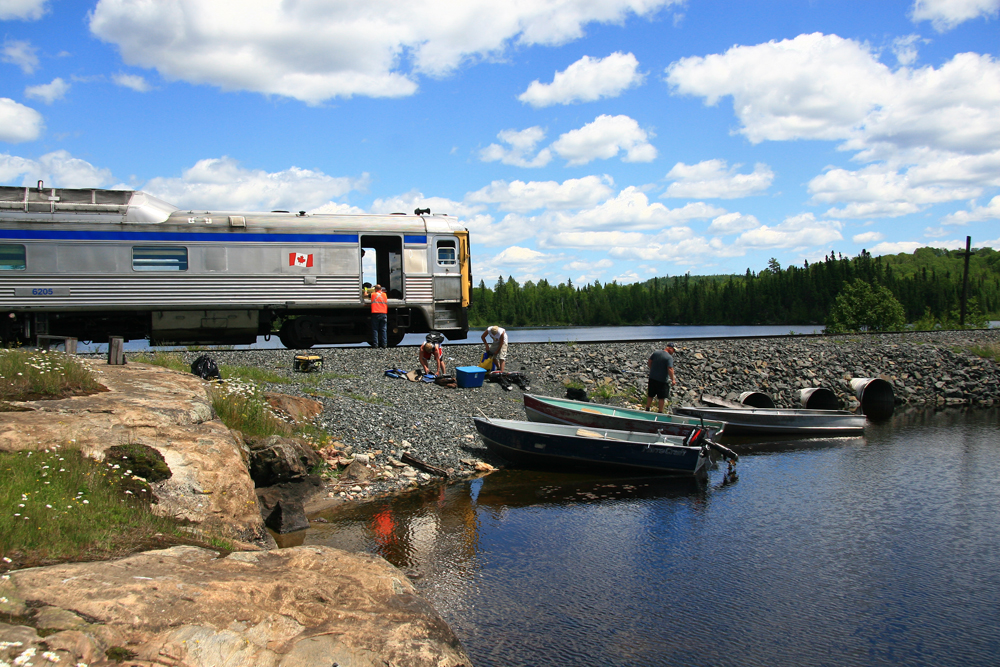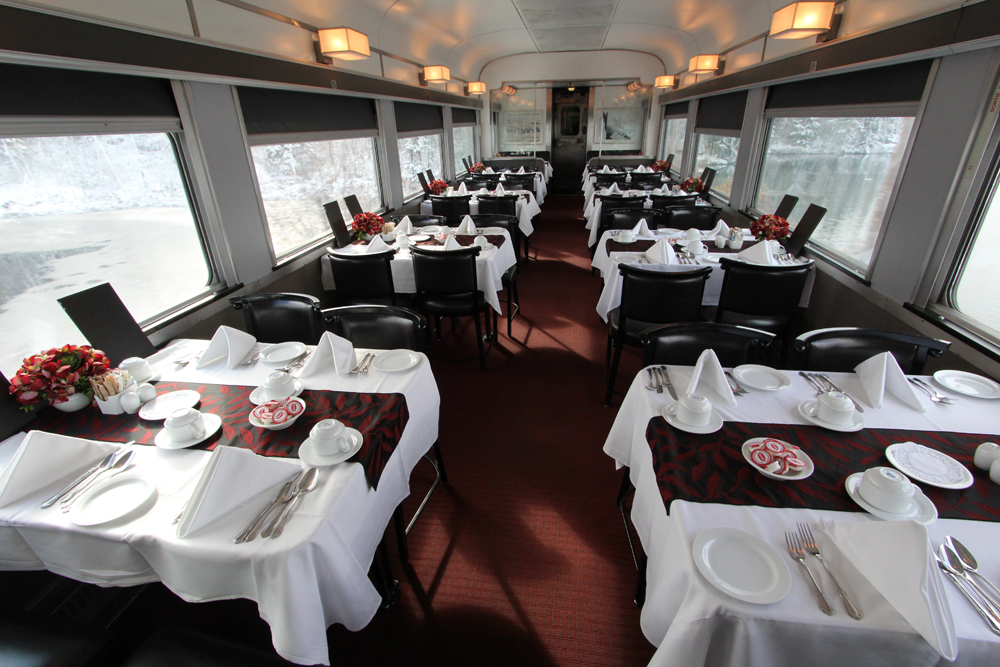
MONTREAL — VIA Rail Canada has issued a formal request for information from potential manufacturers of locomotives and passenger cars who might be interested in re-equipping the company’s long distance and regional remote passenger trains.
VIA’s appeal comes as Amtrak is evaluating responses received from a similar invitation [see “Amtrak seeks carbuilder interest …,” Trains News Wire, Jan. 19, 2022]. It also is taking place while the equipment the company assesses the structural integrity stainless steel cars built by Budd in the 1940s and 1950s — the cars VIA wants to replace [see “VIA: Need for ‘in-depth’ inspections led to buffer car decision,” News Wire, Oct. 19, 2022].
The Canadian operator’s “Long Distance, Regional, and Remote Fleet Renewal Project notice of market consultation,” issued late Friday, Jan. 27, says VIA is looking to select “a supplier to design, manufacture, test, supply, deliver and commission cars and motive power and ancillary equipment (onboard and offboard) with a prescribed capacity of car types (seated coaches, sleeper, diners, multi-purpose, baggage) through an open competitive procurement process.”
VIA will consult with prospective applicants “to solicit feedback on VIA Rail’s proposed technical specifications, maintenance’s scope of work, as well as commercial and contractual related terms.” This is “to reduce the eventual in-market time [and] ensure requirements clarity … prior to commencement of a formal procurement process.” Parties must sign non-disclosure agreements, due by Feb. 17, before taking part.
A general informational session involving prospective applicants is to take place in March, and confidential meetings with individual carbuilders or consortia will begin in May. P1 Consulting was tapped as a “fairness monitor” to attend all meetings.
The expedited timeline to gauge manufacturer interest and begin substantive discussions essentially acknowledges that any manufacturer involved has already responded to Amtrak’s request for information.

Unique to VIA’s network, as presently constituted, are remote services in four Canadian provinces. With the exception of the multi-day Winnipeg-Churchill, Manitoba, overnight train, these don’t require a full complement of sleeping, lounge, and dining cars needed for the Ocean (Montreal-Halifax, Nova Scotia) or Canadian (Toronto-Vancouver, British Columbia). One remote route serving areas inaccessible by highways, the tri-weekly Sudbury-White River, Ontario, train, is currently operated with Budd-built Rail Diesel Cars. Another. between The Pas and Pukatawagan, Manitoba, utilizes VIA’s only remaining non-stainless steel cars, ex-Canadian National holdovers, on a twice-weekly mixed train.
Most manufacturing synergies consistent with Amtrak’s equipment needs, however, involve replacing rolling stock on the Ocean and Canadian. New equipment investment has bypassed replacements for cars built more than 60 years ago that currently ply long distance and remote routes. Instead, VIA has bought equipment for the Quebec City-Windsor, Ontario, corridor: Bombardier’s Light Rapid Comfortable in the 1980s, and 32 five-car Siemens Venture trainsets priced at C$989 million (about $750 million U.S.) now being delivered.
Whatever the manufacturer interest, this inquiry does give VIA management a tangible price tag with which to seek government funding necessary to maintain long-distance service.
It comes as the company is poised to roll out new corridor trains but has been shut out of developing a separate passenger-only “High Frequency Rail” route between Quebec City and Toronto. That project has been usurped by Transport Canada, which has created a separate entity to potentially involve private investors [see “Responding to inquiries, Transport Canada adjusts ..,” News Wire, Nov. 1, 2022].
Transport Canada, as the transportation arm of Canada Prime Minister Justin Trudeau’s Liberal Party administration, also controls the passenger operator’s priorities and funding. In the mid-1980s, VIA tested borrowed Amtrak Superliners after Bombardier bought the design rights to those cars from the defunct Pullman Standard. The tests in a harsh Canadian winter were successful, but the government of Conservative Prime Minister Brian Mulroney not only passed on an investment which would have benefitted Bombardier, but slashed overall funding, precipitating VIA’s severe 1990 downsizing.
More than 30 years later as VIA again seeks to replace its aging cross-country fleet, the future of Canada’s transcontinental passenger rail system hangs in the balance. “VIA: New trains, new challenges” (March 2023 Trains Magazine) provides an in-depth look at the new Siemens trainsets and the forces impacting Canada’s passenger operator.















I rode the Canadian from Montreal to Vancouver in 1975. The equipment was the 1954 cars with domes. A long ride (72 hours almost exactly) but really interesting. We ran on the CP mainline along the north shore of Lake Superior. The morning of the second day, I enjoyed looking out my roomette window at lake and rocky shore (I made sure to reserve a room on that side of the train.) Great memories of that and the Rockies. The food and service was great. We arrived on time.
As for replacement equipment, the Superliners tested successfully in the Canadian climate (If I remember right, they were tested in winter.)
Amtrak and VIA should pool resources for a joint order. Some work could be done in Canada.
Your 72-hour ride would be much longer now and would mean changing trains in Toronto rather than the direct route west of Montreal. Add to that the longer headway as the train no longer runs daily. The Canadian, which I too have ridden (decades ago), has long since ceased to being a serviceable transportation option.
Canadian leaders need to demand something more from VIA in exchange for new cars. Start with this: all trains either run daily or not at all. Continue with this: two parallel routes (CNR and CPR) west of Toronto to Vancouver and two parallel routes (CNR and CPR) from Montreal to the Maritimes.
Either revert to something resembling the timetable of a generation or so ago, or shut the thing down. Read the riot act to both VIA management, and the two railroads.
If I had to redo my trips of the 1980’s when I travelled extensively in Canada, it would take a whole lot more than dome cars and sit-down dining to get me back on the train.
Staedler build some new bilevel cars for the Rockymountaineer just before covid broke out.
Can’t that platform be used for a new generation of long distance equipment in North Anerica?
Don’t know the answer to this, but VIA may have Canadian content requirements (like assemble it in Canada) just as Amtrak has with American content, so a possible joint order may have issues.
I’m pretty sure the new Venture sets built by Siemens are built in California, not Canada, so this may not be an issue with the long distance equipment either.
One reason Via passengers have less problem with the CN side tracking them is that extra time in the dome and especially the diner is so good.